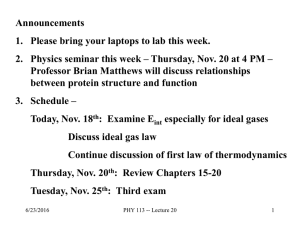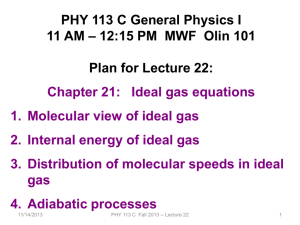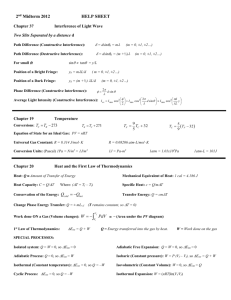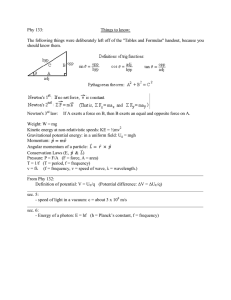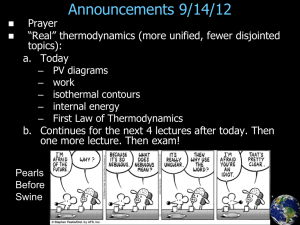Announcements 1. Please bring your laptops to lab this week.
advertisement
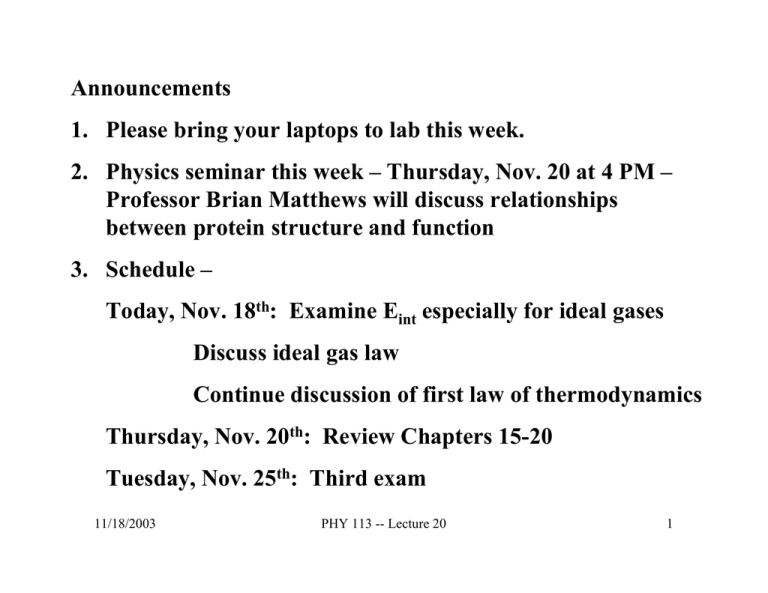
Announcements 1. Please bring your laptops to lab this week. 2. Physics seminar this week – Thursday, Nov. 20 at 4 PM – Professor Brian Matthews will discuss relationships between protein structure and function 3. Schedule – Today, Nov. 18th: Examine Eint especially for ideal gases Discuss ideal gas law Continue discussion of first law of thermodynamics Thursday, Nov. 20th: Review Chapters 15-20 Tuesday, Nov. 25th: Third exam 11/18/2003 PHY 113 -- Lecture 20 1 From The New Yorker Magazine, November 2003 11/18/2003 PHY 113 -- Lecture 20 2 First law of thermodynamics ∆Eint = Q − W Vf W = ∫ PdV Vi For an “ideal gas” we can write an explicit relation for Eint. What we will show: ( ideal gas ) Eint N n = RT = k BT γ-1 γ-1 γ is a parameter which depends on the type of gas (monoatomic, diatomic, etc.) which can be measured as the ratio of two heat capacities: γ=CP/CV. 11/18/2003 PHY 113 -- Lecture 20 3 Thermodynamic statement of conservation of energy – First Law of Thermodynamics ∆Eint = Q - W Work done by system Wif depends on path Heat added to system Qif depends on path “Internal” energy of system ∆Eint = Eint(f)−Εint(i) Î independent on path 11/18/2003 PHY 113 -- Lecture 20 4 How is temperature related to Eint? Consider an ideal gas Î Analytic expressions for physical variables Î Approximates several real situations Ideal Gas Law: PV=nRT volume (m3) pressure (Pa) temperature (K) gas constant (8.31 J/(mole ⋅K)) number of moles 11/18/2003 PHY 113 -- Lecture 20 5 Ideal gas – P-V diagram at constant T PV=nRT Pi Pf Pi Vi = Pf Vf Vi 11/18/2003 Vf PHY 113 -- Lecture 20 6 11/18/2003 PHY 113 -- Lecture 20 7 Microscopic model of ideal gas: Each atom is represented as a tiny hard sphere of mass m with velocity v. Collisions and forces between atoms are neglected. Collisions with the walls of the container are assumed to be elastic. 11/18/2003 PHY 113 -- Lecture 20 8 What we can show is the pressure exerted by the atoms by their collisions with the walls of the container is given by: 2N 1 2N 2 P= K avg 2 m v avg = 3V 3V Proof: Force exerted on wall perpendicular to x-axis by an atom which collides with it: ∆pix 2mi vix Fix = − = ∆t ≈ 2d / vix -vix ∆t ∆t 2mi vix mi vix2 ⇒ Fix ≈ = 2d / vix d vix number of atoms 2 mi vix N Fix d = mi v x2 P=∑ =∑ A dA V i i average over atoms volume 11/18/2003 PHY 113 -- Lecture 20 x 9 Ideal gas law continued: Recall that 1N 2 N ⎧ 1R 2 ⎫ N 2 2 P m v m v = = = x Macroscopic relation : PV = nRT = N⎨ m Tv = ⎬Nk BT 3V 3 V ⎩ 2N V ⎭ A 2 1 Microscopic model : PV = N ⎧⎨ m v 2 ⎫⎬ = Nk BT 3 ⎩2 ⎭ Therefore: ⎧ 1 3 2 ⎫ ⎨ m v ⎬ = k BT ⎩2 ⎭ 2 ⇒ vrms = Also: v 2 3k BT = m ⎧1 m v 2 ⎫ = 3 k T ⎨ ⎬ B 2 2 ⎩ ⎭ 1 3 ⎧ 2 ⎫ ⇒ Eint = N ⎨ m v ⎬ = N k BT 2 ⎩2 ⎭ 11/18/2003 PHY 113 -- Lecture 20 10 Big leap! Internal energy of an ideal gas: 1 3 N n k BT = RT Eint = N ⎧⎨ m v 2 ⎫⎬ = N k BT ⇒ 2 γ-1 γ-1 ⎩2 ⎭ derived for monoatomic ideal gas Gas He N2 H2O 11/18/2003 more general relation for polyatomic ideal gas γ (theory) 5/3 7/5 4/3 PHY 113 -- Lecture 20 γ (exp) 1.67 1.41 1.30 11 Determination of Q for various processes in an ideal gas: n Eint = RT γ-1 n ∆Eint = R∆T = Q − W γ-1 Example: Isovolumetric process – (V=constant Î W=0) n ∆Eint i → f = R∆Ti → f = Qi → f γ-1 n In terms of “heat capacity”: Qi → f = R∆Ti → f ≡ nCV ∆Ti → f γ-1 R CV = γ-1 11/18/2003 PHY 113 -- Lecture 20 12 Example: Isobaric process (P=constant): ∆Eint i → f n = R∆Ti → f = Qi → f − Wi → f γ-1 In terms of “heat capacity”: Qi → f = n n R∆Ti → f + Pi (V f − Vi ) = R∆Ti → f + nR∆Ti → f ≡ nC P ∆Ti → f γ-1 γ-1 R γR ⇒ CP = +R= γ-1 γ-1 Note: γ = CP/CV 11/18/2003 PHY 113 -- Lecture 20 13 More examples: Isothermal process (T=0) n RT γ-1 n = R∆T = Q − W γ-1 Eint = ∆Eint Î∆T=0 Î ∆Eint = 0 Î Q=W ⎛V f dV W = ∫ PdV = nRT ∫ =nRT ln⎜⎜ Vi Vi V ⎝ Vi Vf 11/18/2003 Vf PHY 113 -- Lecture 20 ⎞ ⎟⎟ ⎠ 14 Even more examples: Adiabatic process (Q=0) ∆Eint = −W n R∆T = − P∆V γ-1 PV = nRT ∆PV + P∆V = nR∆T nR∆T = −(γ-1)P∆V = ∆PV + P∆V ∆V ∆P −γ = P V ⎛ V fγ ⎞ ⎛ Pf ⎞ ⎟ ⎜ ⇒ − ln γ = ln⎜⎜ ⎟⎟ ⇒ PiVi γ = Pf V fγ ⎜V ⎟ ⎝ Pi ⎠ ⎝ i ⎠ 11/18/2003 PHY 113 -- Lecture 20 15 PiVi γ Adiabat : P = γ V PiVi Isotherm : P = V 11/18/2003 PHY 113 -- Lecture 20 16 Peer instruction question Suppose that an ideal gas expands adiabatically. Does the temperature (A) Increase (B) Decrease (C) Remain the same PiVi γ = Pf V fγ Ti PiVi = nRTi ⇒ Pi = nR Vi TiVi γ-1 = T f V fγ-1 ⎛ Vi T f = Ti ⎜⎜ ⎝V f 11/18/2003 ⎞ ⎟ ⎟ ⎠ γ -1 PHY 113 -- Lecture 20 17 Review of results from ideal gas analysis in terms of the specific heat ratio γ ≡ CP/CV: n R ∆Eint = R∆T = nCV ∆T ; CV = γ-1 γ-1 γR CP = γ-1 For an isothermal process, ∆Eint = 0 Î Q=W Vf ⎛V f ⎞ ⎛V f ⎞ W = ∫ PdV =nRT ln⎜⎜ ⎟⎟ = PiVi ln⎜⎜ ⎟⎟ Vi ⎝ Vi ⎠ ⎝ Vi ⎠ For an adiabatic process, Q = 0 PiVi γ = Pf V fγ TiVi γ-1 = T f V fγ-1 11/18/2003 PHY 113 -- Lecture 20 18 Extra credit: Show that the work done by an ideal gas which has an initial pressure Pi and initial volume Vi when it expands adiabatically to a volume Vf is given by: γ −1 Vf ⎛ PiVi ⎜ ⎛⎜ Vi ⎞⎟ ⎞⎟ W = ∫ PdV = 1− ⎜ ⎟ γ − 1⎜ ⎝ V f ⎠ ⎟ Vi ⎝ ⎠ 11/18/2003 PHY 113 -- Lecture 20 19 Peer instruction questions Match the following types of processes of an ideal gas with their corresponding P-V relationships, assuming the initial pressures and volumes are Pi and Vi, respectively. 1. Isothermal 2. Isovolumetric 3. Isobaric 4. Adiabatic (A) P=Pi 11/18/2003 (B) V=Vi (C) PV=PiVi PHY 113 -- Lecture 20 (D)PVγ=PiViγ 20 P (1.013 x 105) Pa Examples process by an ideal gas: Pf B C A→B Q A Pi Vi 11/18/2003 D Vf W C→D D→A Vi ( Pf − Pi ) γPf (V f − Vi ) − V f ( Pf − Pi ) -γPi (V f − Vi ) γ -1 γ -1 γ -1 γ -1 0 ∆Eint B→C Pf(Vf-Vi) 0 -Pi(Vf-Vi) Vi ( Pf − Pi ) Pf (V f − Vi ) − V f ( Pf − Pi ) -Pi (V f − Vi ) γ -1 γ -1 γ -1 γ -1 Efficiency as an engine: PHY 113 -- Lecture 20 e = Wnet/ Qinput 21 11/18/2003 PHY 113 -- Lecture 20 22
